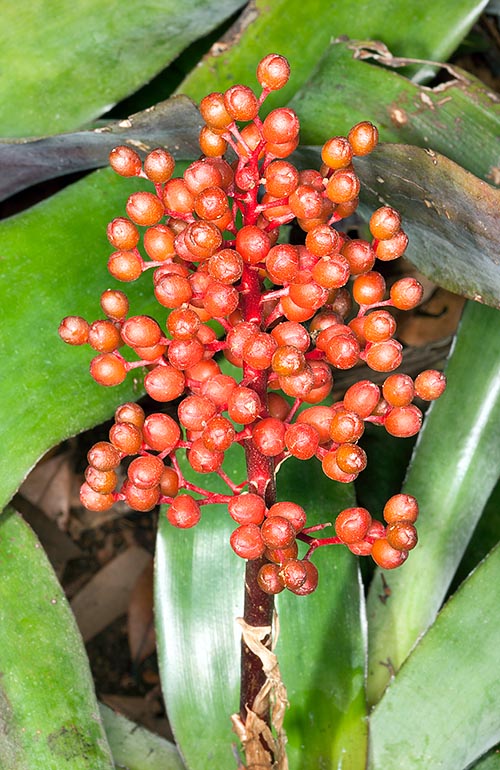Family : Bromeliaceae

Text © Pietro Puccio

English translation by Mario Beltramini

Aechmea fulgens with fruits. It blooms once only then dies © Giuseppe Mazza
The species is native to north-eastern Brazil (Alagoas, Bahia, Ceará, Fernando de Noronha, Maranhão, Paraiba, Pernambuco, Piauí, Rio Grande do Norte e Sergipe), where it lives in the Atlantic forest as epiphytic on the trees, as well as terrestrial on rocky outcrops.
The name of the genus comes from the Greek “aichme” = spearhead, with reference to the thorny apices of the sepals and of the floral bracts; the name of the species is the Latin participle “fulgens” = bright, shining.
Common names: coral berry (English).
The Aechmea fulgens Brongn. (1841) is an evergreen herbaceous species, monocarpic (fructifies once only and then dies), acaulous, epiphytic or terrestrial, about 50 cm tall, inflorescence included, presenting a funnel-shaped rosette of several leaves placed in way to form a central cavity usually full of water.
The leaves are curved, 30-45 cm long and 5-6 cm broad, with thorny margins and rounded apex equipped with one thorn, of green colour on the upper page, waxy grey below. Inflorescence, at the centre of the rosette, formed by an erect floral scape, 20-25 cm long and of 1 cm of diameter, ending in a compound raceme, about 20 cm long, formed by 3-8 racemes departing from the central axis, of red colour, 5-8 cm long, carrying sessile (that is, without petiole) flowers with red sepals, 0,5 cm long, petals of violet turning red when withering colour and red ovary when ripe.
The fruits are red globose berries, persistent for many months. Besides by seed, it reproduces in vegetative way through the new plants coming out at the base of the plant and which may be detached when having a size of at least one third of that of the mother plant. The species is one of the most cultivated as indoor plant for the contained size and the beauty of the inflorescence as well as of the long-lasting infructescence.
It can be cultivated in open spaces in the tropical and in the humid subtropical climate zones in filtered sunlight, as epiphytic on the trees as well as terrestrial, on a layer of soil rich in humus slightly elevated from the ground in order to avoid stagnations; its cultivation can be tried in the milder areas of the warm temperate zones where the temperatures around the 0 °C are a short-lasting exception.
In pot, for indoor decoration, it requires a light substratum, aerated, rich in organic substance with addition of coarse siliceous sand, and a very luminous exposition, but not at the direct sun, with lowest winter temperatures preferably not under the 14 °C. The waterings must be abundant in summer and reduced in winter and the high ambient humidity, increased, in presence of dry air and of high temperatures, with nebulisations by utilizing ambient temperature water and not calcareous in order to avoid unaesthetic spots on the leaves. In summer, some water can be left in the central cavity formed by the rosette of leaves, renewing it frequently for avoiding it becomes a larval nest of mosquitoes, whilst, in winter, it is better to leave it rather dry, in presence of low temperatures, for avoiding possibly rottenness.
Synonyms: Aechmea discolor C.Morren (1846); Lamprococcus fulgens (Brongn.) Beer (1856).
→ For general notions about BROMELIACEAE please click here.
